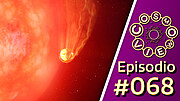Astronomers Find Potentially Volcano-Covered Earth-Size World
Credit: NASA’s Goddard Space Flight Center/Chris Smith (KRBwyle)
Download high-resolution video and images from NASA’s Scientific Visualization Studio
Cambridge, MA--Astronomers
have discovered an Earth-size exoplanet, a world beyond the solar
system, that may be carpeted with volcanoes and could potentially
support life. Called LP 791-18d, the planet could undergo volcanic
outbursts as often as Jupiter's moon Io, the most volcanically active
body in the solar system.
The planet was first reported in Nature
and the discovery was made possible in part due to ground-based
observations made by the Center for Astrophysics | Harvard &
Smithsonian.
LP 791-18d orbits a small red dwarf star about 90 light-years away in
a southern constellation called Crater. The team behind the discovery
estimates it is only slightly larger and more massive than Earth. It is
tidally locked, which means the same side constantly faces its star. The
side facing the star would probably be too hot for liquid water to
exist on the surface, but the team suspects that the amount of volcanic
activity potentially taking place all over the planet could sustain an
atmosphere. These conditions may allow water to condense on the dark
side of the planet.
Discovery of the planet was made possible through a combination of
space-based and ground-based observations. The researchers discovered
and studied the planet using data from NASA's Transiting Exoplanet Survey Satellite (TESS) and retired Spitzer Space Telescope, as well as a suite of ground-based observatories organized by Collins.
The team initially estimated the planet's mass by measuring tiny
differences in the time it takes the planet to orbit its host star from
one orbit to the next, which are caused by the gravitational tug of the
other planets in the system.
The planet's volcanic activity might arise from other planets in the
same system. Before the discovery of LP 791-18d, astronomers already
knew about two other worlds in the system, including LP 791-18c. The
outer planet, c, is much larger and more massive than planet d.
During each orbit, planets d and c pass very close to each other.
During each close pass, the more massive planet c produces a
gravitational tug on the newly discovered planet d, making its orbit
somewhat elliptical. On this elliptical path, planet d deforms slightly
more every time it goes around the star. These deformations can create
enough internal friction to substantially heat the planet's interior and
produce volcanic activity at its surface. Jupiter and some of its moons
affect Io in a similar way.
Planet d sits on the inner edge of the habitable zone, the
traditional range of distances from a star where scientists hypothesize
liquid water could exist on a planet's surface. If the planet is as
geologically active as the research team suspects, it could maintain an
atmosphere. Temperatures could drop enough on the planet's night side
for water to condense on the surface.
Researchers have already received approval to study planet c using the recently launched James Webb Space Telescope, and the team thinks planet d is also an exceptional candidate for atmospheric studies by the mission.
"A big question in astrobiology, the field that broadly studies the
origins of life on Earth and beyond, is if tectonic or volcanic activity
is necessary for life," said co-author Jessie Christiansen, a research
scientist at NASA's Exoplanet Science Institute
at the California Institute of Technology (Caltech). "In addition to
potentially providing an atmosphere, these processes could churn up
materials that would otherwise sink down and get trapped in the crust,
including those we think are important for life, like carbon."
"This discovery is just a first step," Collins said. "With the
potential to continue studying this planet with the James Webb Space
Telescope, we will be able to fine-tune our observations and learn more
about the planet's likely volcanically fueled atmosphere. Future
discoveries will help us understand how the ingredients of life might
have come to be on worlds other than our own."
Other members of the research team from the CfA include David Charbonneau, Ryan Cloutier, David W. Latham, and Samuel N. Quinn.
TESS is a NASA Astrophysics Explorer mission led and operated by MIT
in Cambridge, Massachusetts, and managed by NASA's Goddard Space Flight
Center in Greenbelt, Maryland. Additional partners include Northrop
Grumman, based in Falls Church, Virginia; NASA’s Ames Research Center in
California's Silicon Valley; MIT’s Lincoln Laboratory; and the Space
Telescope Science Institute in Baltimore. More than a dozen
universities, research institutes and observatories worldwide
participate in the mission.
Spitzer's observations of the system where LP 791-18d resides were among the last the satellite collected before it was decommissioned
in January 2020. The entire body of scientific data collected by
Spitzer during its lifetime is available to the public via the Spitzer
data archive, housed at the Infrared Science Archive at IPAC at Caltech
in Pasadena, California. NASA's Jet Propulsion Laboratory, a division of
Caltech, managed Spitzer mission operations for the agency’s Science
Mission Directorate in Washington. Science operations were conducted at
the Spitzer Science Center at IPAC at Caltech. Spacecraft operations
were based at Lockheed Martin Space in Littleton, Colorado.
About the Center for Astrophysics | Harvard & Smithsonian
The Center for Astrophysics | Harvard & Smithsonian is a
collaboration between Harvard and the Smithsonian designed to ask—and
ultimately answer—humanity's greatest unresolved questions about the
nature of the universe. The Center for Astrophysics is headquartered in
Cambridge, MA, with research facilities across the U.S. and around the
world.
Media Contact:
Peter Edmonds
Interim CfA Public Affairs Officer
Center for Astrophysics | Harvard & Smithsonian
+1 617-571-7279
pedmonds@cfa.harvard.edu


























